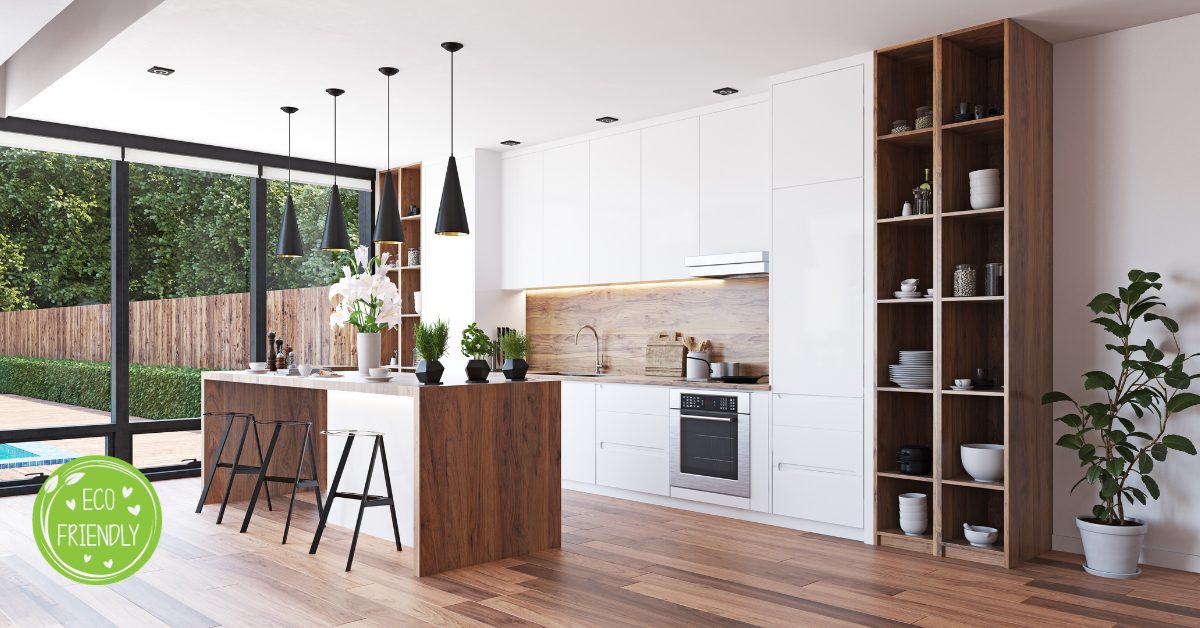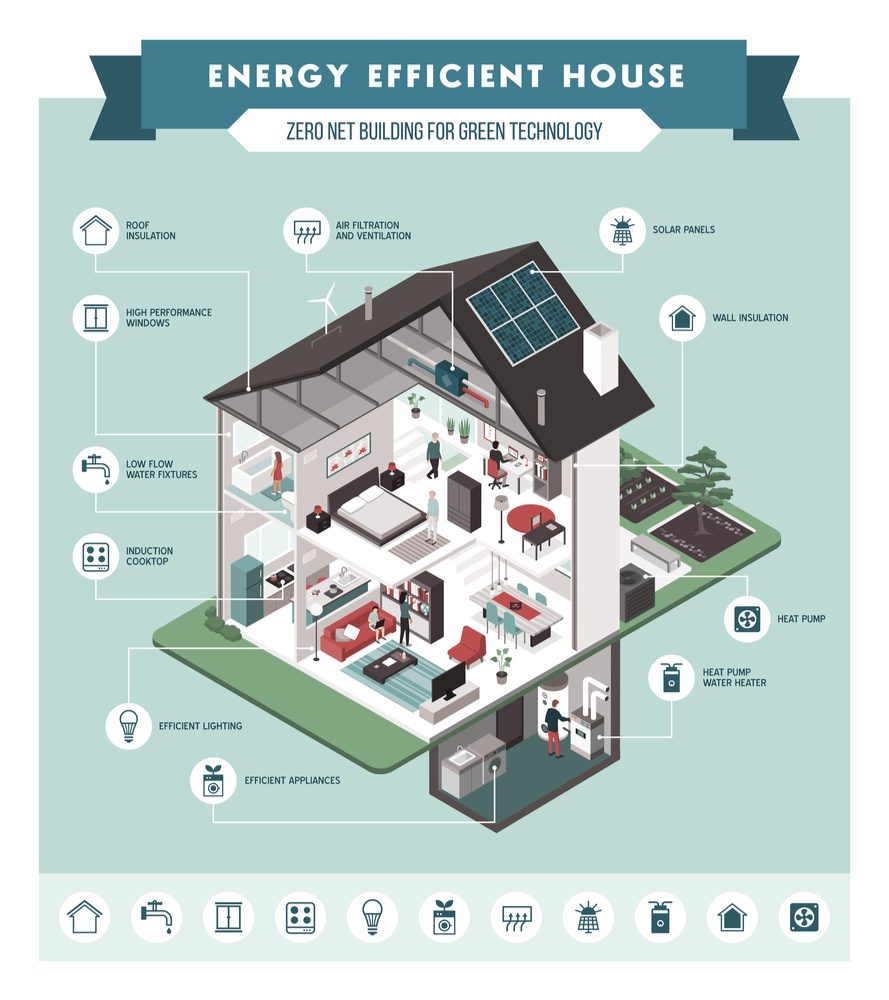As of 2021, 85% of people around the world consider ecological impact when making purchases. Sustainable products are gaining traction in the global market, making consumers more conscious of eco-friendly options.
Large scale upgrades to your home could have a significant impact in the long-term.
With this knowledge, we can seek ways to reduce our carbon footprints and move toward a more energy efficient home. These changes don’t all come cheap! Nonetheless, investing in the energy efficiency of our homes is an investment in sustaining our home planet, and can result in a healthy ROI too.

There are steps, large and small, that can be taken toward leading an environmentally conscious lifestyle. The first is reflecting on the areas of daily life that we can make more sustainable.
As consumers, one adjustment to consider is our household energy use. From heating, cooling and powering our homes, household energy consumption is accountable for an estimated 20% of energy-related greenhouse gas emissions released by the United States.
Upgrades for a More Energy Efficient Home
Flooring
To start from the bottom up, first look at the floors of your home. One of the most sustainable materials out there is bamboo.
Why is bamboo flooring an energy-efficient choice for your home?
- Bamboo boasts a regrowth rate that is almost 1/10 of that of trees used for traditional hardwood flooring. Bamboo takes 3-7 years to regenerate while trees used for hardwoods can take anywhere from 40 to 70 years!
- It is also reported to produce ‘effectively zero’ formaldehyde emission. This all comes at a comparable price point to other eco-friendly flooring options.
- It keeps your home cooler on hot days, and warmer on chilly days, which saves on energy bills and lessens your carbon footprint!
- And bonus – They are the ideal choice for allergy-prone family members!
If you’re still not warming up to the idea of bamboo floors, it may be worth considering radiant heat floors. Heat is one of the highest energy-consuming systems in our homes. Radiant heat floors help distribute heat throughout the home more efficiently, therefore consuming less energy and lowering heat bills by 15% on average.
Renewable Energy Sources
The most obvious way to reduce greenhouse gas emissions is to stop relying on fossil fuels as your home’s energy source. Installing solar panels is one alternative solution.
While the price for solar panel installation may vary, the bright side is there are also an abundance of benefits to reap. Besides being cleaner for our atmosphere,
- Solar panel users can also enjoy tax deductions of up to 30% and savings on energy bill costs!
- On top of this, you get to save on your energy bills
- There is more than enough sunlight to meet demands, so you will never run out of power
- You never have to fear electrical grid failures!
Windows and Door Insulation
Depending on the season, you’ll want to keep the heat in or out of your home without racking up a high energy bill. Install newly insulated windows and doors or reseal the insulation of existing ones. This improves your home’s ability to maintain desired temperatures without relying on the thermostat.
With your home’s insulation doing the heavy lifting for temperature control, you will, in turn, consume less fossil fuel energy to heat or cool your home. The cash you fork over for this project has the potential to come right back into your pockets as you begin saving money on your energy bills and spending less on your air conditioner to keep you cool.
Green Technology
Consider the amount of energy it takes you to run a load of laundry or keep your food refrigerated. Updating outdated appliances to models that use more sustainable technology can dramatically affect your level of energy consumption in these processes.
In the Laundry
Experts at Energy Star, the nationally recognized symbol for energy efficiency, suggest revamping laundry room appliances by swapping to those that conserve water and energy such as front load washing machines and heat-pump dryers.
Using eco-friendly detergents in our wash loads and cutting down on the use of wasteful products like dryer sheets can also significantly reduce the amount of toxins and pollutants that are released into our water supply and landfills.
In the Kitchen
Switch to energy efficient refrigerators, ovens and dishwashers, and be on the lookout for companies who are committed to the sustainable disposal of these products after they’ve served their purpose.
Smart Tech for Sustainability
In today’s fast-paced world, we all strive for convenience, and smart technology is here to make our lives easier while being kind to our planet. The rapid evolution of smart technology empowers homeowners to finely tune their control over home energy consumption.
- Smart thermostats offer homeowners the ability to cut down on energy waste by decreasing utility expenses while contributing to a more eco-friendly footprint.
- Home automation plays a pivotal role in eradicating phantom power consumption and minimizing energy wastage, fostering a more sustainable way of living.
- By incorporating smart lighting, energy inefficiency is minimized. So we are talking less energy consumption, lower electricity costs, and a more environmentally friendly home.
- Battery Energy Storage Systems store surplus electricity produced from renewable sources like solar panels, releasing it on demand, contributing to a more stable energy grid.
Smart technology in your home can truly contribute to an energy-efficient lifestyle, and it’s an investment that pays off in both your comfort and your wallet. So, go ahead, make your home smarter and more energy-efficient while making the planet a happier place for all of us!
Investing in the Future of Our Planet
Although eco-friendly home features may come at higher upfront costs, investing money and time into the health and stability of our environment has a high return on investment.
In fact, the theme of Earth Day in 2023 was “Invest in Our Planet,” a great reminder that the effort we put into preserving our planet has a direct impact on the preservation of a high quality of life.
Financial ROI
Switching to an energy-efficient home is a savvy financial move that pays back in many ways. To name only three:
- Decreased Energy Costs: Energy-efficient structures consume less energy, resulting in reduced energy expenditure. This, in turn, results in substantial long-term savings.
- Impressive tax credits: Transitioning to an energy-efficient home in the USA can lead to substantial tax benefits, thanks to various federal and state incentives designed to encourage energy-saving upgrades. From the Residential Renewable Energy Tax Credit to state-specific programs, these benefits can put more money back in your pocket while you reduce your carbon footprint.
- Increased property value: According to the 2023 Realtors and Sustainability Report by the National Association of Realtors (NAR), a noteworthy 50% of real estate agents and brokers have facilitated property transactions involving eco-sustainable features within the last 12 months.
As the saying goes, “there is no Planet B.” We have one habitat to commit our time and resources into: the Earth. Improving the current state of our environment and protecting the environment from further damage are valuable for sustainable development and our future. Starting at home is a great first step for an individual to take toward leading a greener lifestyle.

About the Author
Meet Bridgett, your friendly neighborhood green building guru! With more years of experience than she’d like to admit, Bridgett is your go-to expert for all things eco-friendly construction. She’s on a mission to make your home the envy of every tree hugger in town (and maybe even the squirrels 🐿️). Let’s build a greener, funnier, and all-around better world together – one enlightened eco-conscious choice at a time!

